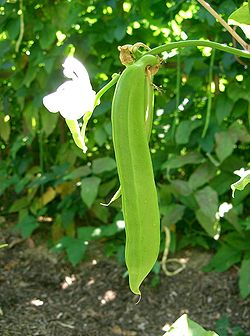Typical yield
5.7 t/ha
Varieties
1
Pest/Disease
5
Seasons
1
Profile
- Growth habit
- climber
- Lifecycle (days)
- 120–180
- Primary uses
- Green manure; forage; pulse (processed)
- Pollination
- insect
- Origin / distribution
- Pantropical; adapted to warm humid/subhumid zones
Environment
Climate
Temp optimal
22–30 °C
Rain optimal
900–1500 mm/yr
Altitude
0–1600 m
Soil
pH optimal
5.5–6.8
Soil type
Light to medium soils; well-drained
Farmer Guide
Row spacing
100 cm
Plant spacing
50 cm
Depth
3 cm
Seed rate
25 kg/ha
Nursery days
Planting: Direct-seed at onset of rains; provide trellis or allow to sprawl as green manure.
Transplanting: Not transplanted.
Irrigation: Rainfed in humid zones; irrigate during dry spells to support flowering/pod set.
Fertigation: Minimal N (fixing legume); ensure P and K; add S/Ca if deficient.
Pest scouting: Scout for pod borers and beetles; maintain sanitation and timely picking.
Pruning/Training: Train vines on supports where seed yield is the goal.
Harvest: For green manure, incorporate at flowering; for grain, harvest when pods brown and seeds hard.
Postharvest: Dry seed to ≤12% moisture; store cool/dry; cook/process thoroughly before food use.
Nutrient Schedule
| # | Stage | DAP | Product | Rate | Targets (kg/ha) | Notes |
|---|---|---|---|---|---|---|
| 1 | Basal | 0 | NPK 15-15-15 (light) | 50 kg/ha | N: —, P₂O₅: —, K₂O: — | Or DAP+MOP equivalent; keep away from seed inoculant |
| 2 | Early pod set (opt.) | 40 | Sulfate of potash (SOP) | 40 kg/ha | N: —, P₂O₅: —, K₂O: 20 | Skip if soil K is adequate |
Nutrient Requirements
| Nutrient | Stage | Amount | Unit |
|---|---|---|---|
| N | Basal | 0 | kg/ha |
| P₂O₅ | Basal | 20 | kg/ha |
| K₂O | Basal | 20 | kg/ha |
| N | Topdress | 0 | kg/ha |
| P₂O₅ | Topdress | 0 | kg/ha |
| K₂O | Topdress | 20 | kg/ha |
Images

| Name | Country | Maturity | Traits |
|---|---|---|---|
| Local Canavalia | KE | 150 | Vigorous vine; dual purpose |
| Stage | Product | Rate (kg/ha) | Notes |
|---|---|---|---|
| Basal | NPK 15-15-15 | 50 | Or banded P+K sources |
| Pod set | Sulfate of potash (SOP) | 40 | Apply only if K is low |
| Name | Type | Symptoms | Management |
|---|---|---|---|
| Pod borers | pest | Pod damage | Frequent picking; sanitation |
| Pod borers (Helicoverpa/Maruca) | pest | Bored pods; seed damage | Flower–pod scouting; threshold sprays; timely harvest |
| Leaf beetles | pest | Defoliation; shot-holes | Early control if severe; conserve natural enemies |
| Aphids | pest | Leaf curl; honeydew/sooty mold | Control ants; soft insecticides; encourage predators |
| Root rots (Rhizoctonia/Pythium) | disease | Damping-off; root lesions | Well-drained fields; seed treatment; avoid overwatering |
| System | Typical | Min | Max | Notes |
|---|---|---|---|---|
| green manure | 8 | 4 | 12 | Biomass (DM) |
| green manure (biomass DM) | 8 | 4 | 12 | Dry matter biomass |
| rainfed seed | 1 | 0.6 | 1.8 | Clean seed under good management |
| Country | Region | Planting | Harvest |
|---|---|---|---|
| KE | Humid lowlands | Mar–Apr | Jul–Nov |
| Country | Region | Suitability |
|---|---|---|
| KE | Humid lowlands | High |
| TZ | Coastal belt | High |
| UG | Lake Victoria basin | Medium |
